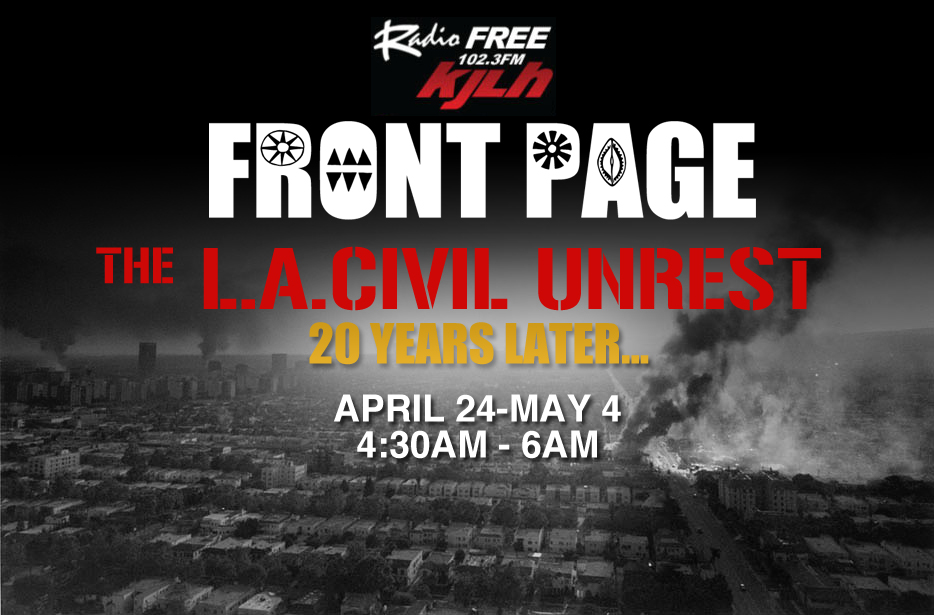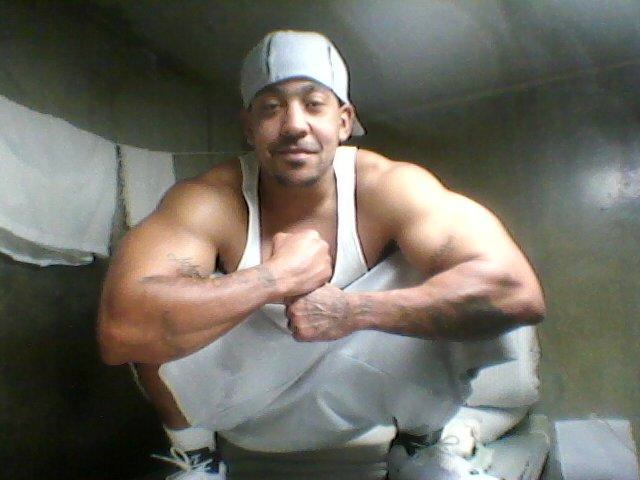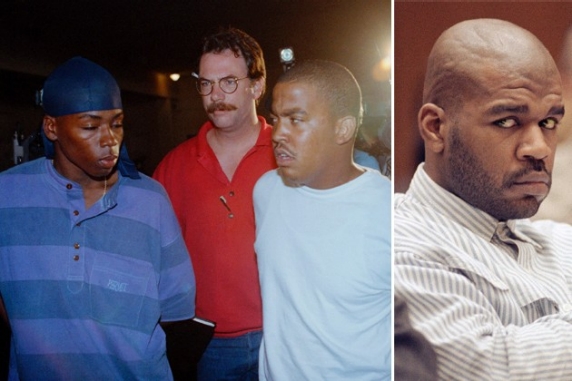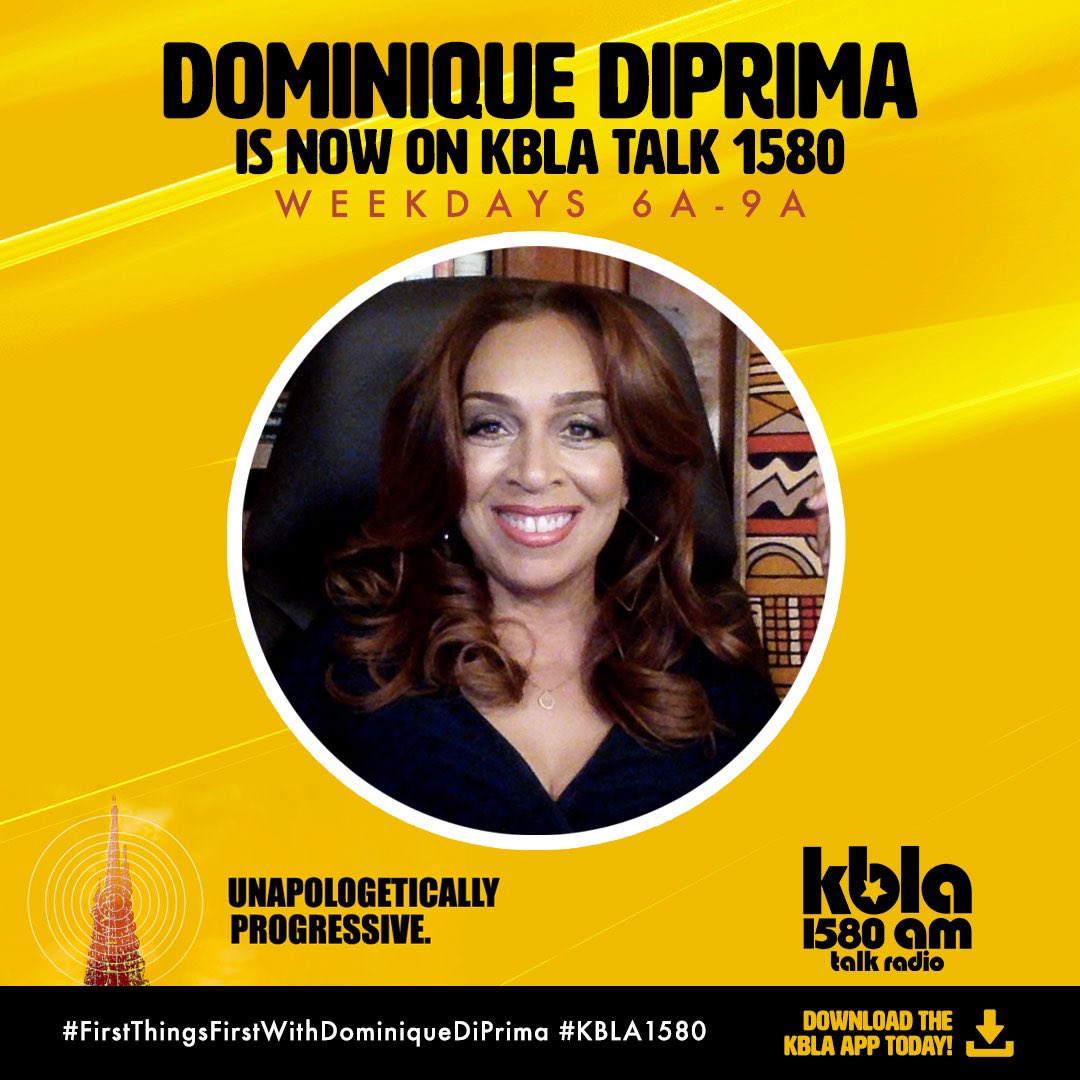A look back at a memorable Front Page show on KJLH-FM when Los Angeles’ Black community sounded off on the death of former L.A. Police Chief Darryl Gates (April 19, 2010).
The Front Page walks back down memory lane with updates on some of the most infamous people connected to the 1992 L.A. Rebellion with Where are they now? Audio available at 2 p.m. PST.

GEORGE HOLLIDAY
Shortly after midnight on March 3, 1991, George Holliday awoke to the sounds of police sirens and helicopters outside his apartment. He grabbed his Sony Handycam and began filming.
His nine minutes of grainy footage ignited furious charges of racial injustice. He received $500 from KTLA-TV Channel 5 for rights to broadcast the tape. He owns a copy — the original remains in federal archives.
Holliday, an Argentine plumber who moved to the U.S. in 1980, still lives and works in the San Fernando Valley. He told The Times a decade ago: “I know that my name appears in the history books. To me, that’s the coolest part of this whole thing.”

RODNEY G. KING
By the end of his beating by LAPD officers, Rodney King had a broken cheekbone, a fracture at the base of his skull and a broken a leg.
Although King was driving under the influence and was on parole for armed robbery, he was never charged. He was awarded $3.8 million in compensation by the city.
King, 47, has spent his multimillion dollar award. He has had frequent run-ins with police for domestic violence, substance abuse and driving under the influence. He has appeared on Vh1’s “Celebrity Rehab,” tackling his alcoholism, and just published a book, “The Riot Within, My Journey from Rebellion to Redemption.” He lives in Rialto.

STACEY C. KOON
Stacey C. Koon, an LAPD sergeant at the beating scene, was acquitted in state court but was one of two officers convicted of federal civil rights violations. He served 30 months in prison and wrote a book, raising $4 million in legal funds.
Koon, 61, does not talk about his personal life because of continued death threats, said his lawyer Ira M. Salzman. “He’s a committed family man,” Salzman said. “And he’s moving forward with his life as best as he can.”

LAURENCE M. POWELL
Laurence M. Powell, the officer seen delivering the majority of the 56 baton blows during the 81 seconds of videotaped beating, was the only one not fully acquitted in the state trial. He was convicted with Koon in the federal case and was released in 1996 after serving a 30-month sentence.
Powell rarely spoke to the media. In a statement sent to the Times in 1992 by a family friend, Powell said that he “never harbored any personal malice toward Mr. King,” noting that his family, while he was growing up, had cared for foster children of different races.
Powell, who worked with computers while he was in prison, later worked in the computer retailing industry. Now 49, he lives in San Diego County, according to public records.

TIMOTHY E. WIND
Timothy E. Wind, 10 months out of the Police Academy, was training under Powell the night of the King beating. He struck King with his baton and kicked him, but was twice acquitted of any criminal wrongdoing. Wind, who was badly unnerved by the two trials, was the only defendant who did not testify during the trial.
The LAPD fired him. He took a part-time job as a community service officer for the Culver City Police Department in 1994, which some residents protested.
In 2000, he left that job when he was admitted into Indiana University’s law school. He graduated in 2003 and is remembered by professors as a good student with excellent writing skills. Wind, now 51, could not be reached and lives in Kansas, according to public records and acquaintances.

THEODORE J. BRISENO
Theodore J. Briseno was twice acquitted of criminal charges. He was the only defendant to break ranks and testify against the other three officers who were charged, describing them as “out of control.”
He acknowledged that he stomped on King late in the video, saying he was trying to stop him from moving.
Briseno, a 10-year LAPD veteran, was fired in 1994 and unsuccessfully fought to keep his job. He is 59, and property records show he lives in Illinois.

DARYL F. GATES
Police Chief Daryl F. Gates refused to step down after the King episode. He apologized but called it an aberration in the LAPD.
Gates became a polarizing figure, reviled by LAPD critics and lauded by people who wanted the department to forcefully put down the violence.
A commission later blamed Gates for a slow police response to the riots. He retired a month after the riots and moved to Orange County. He died in 2010. Thousands mourned in a downtown procession.

SOON JA DU
Two weeks after King’s beating, Korean American grocer Soon Ja Du fatally shot 15-year-old Latasha Harlins after a dispute over a bottle of orange juice. Latasha died with $2 in her hand.
Du faced a possible 16 year sentence in state prison. A judge sentenced her to probation, saying she was in fear from earlier robberies. The sentence and a surveillance video of Latasha being shot in the back inflamed racial tensions and became symbols of what many believed was a double standard of justice.
Du’s store burned in the rioting and never reopened. Du, 71, lives in the San Fernando Valley.

REGINALD O. DENNY
Hours after a Ventura County jury found Koon, Powell, Briseno and Wind not guilty on April 29, 1992, millions watched on TV as truck driver Reginald O. Denny was stopped at Florence and Normandie avenues, dragged from his truck and beaten unconscious with a brick, a tire iron and a fire extinguisher. He had more than 90 skull fractures.
He went through years of therapy, working on his speech and regaining the ability to drive. Now 56, he works as a boat mechanic in Lake Havasu, Ariz., and “he’s getting along somewhat,” a family member said.
DAMIAN M. WILLIAMS
Two weeks after Reginald Denny was beaten, Damian “Football” Williams, the man who smashed Denny’s head with a brick, was arrested in a raid by 100 state and federal officers.
Williams, who was 19 at the time of the incident, was convicted and served four years of a 10-year sentence.
After his release, he was arrested and convicted of aiding in a murder at a drug house in 2000 and sentenced to 46 years to life. Williams, 39, is in Calipatria State Prison.
His mother Georgiana Williams is still a Front Page listener and active member of the community and lives in Fontana.
Click here to listen to Williams’ interview with Jasmyne Cannick.
Antoine “Twan” Miller
Miller was a 19-year-old who lived with the Williams family. Miller’s mother was a drug addict; and as a child, Miller was sent to live with his grandmother. When he was 12, his grandmother killed his grandfather and was convicted of this murder, leaving Miller homeless. Williams’ mother, well-known around the neighborhood as kind and caring, took Miller into her home. Miller’s only previous arrest was for joyriding. At the age of 31, Miller was shot and killed in a Hollywood nightclub on February 1, 2004.
Henry Keith “Kiki” Watson
Henry was a 27-year-old former U.S. Marine and an ex-convict who had served time for robbery. After his release from prison, he married, had children and was working two jobs. According to Williams, Watson was known around the neighborhood as a “gentleman”. After he was freed from jail in 1993, he appeared on the Phil Donahue show and apologized to Denny for the attacks. Later, he would serve three years in prison for a narcotics conviction. Fifteen years after the attacks, Watson said during an interview “Nobody specifically sought out Reginald Denny to cause him any harm. We got caught up in the moment, just like everyone else.” As of 2012, Watson still lives in Los Angeles and operates his own limousine service.
Gary Williams (unrelated to Damian Williams)
Gary was alleged to be a habitual crack user who was routinely reported seen at a local gas station as a beggar.
Anthony Brown
Anthony was also a member of Eight Tray Gangster Crips.
Lance Parker
Lance was a 26-year-old process server who had no previous criminal record.





No Comments
Comments for 20 YEARS LATER: Where Are they Now? are now closed.